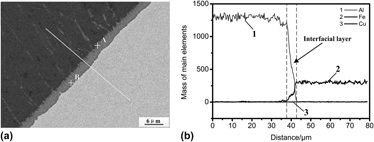Crossref Citations
This article has been cited by the following publications. This list is generated based on data provided by
Crossref.
Das, Atanu
and
Bang, Hee-Seon
2018.
Laser and Gas Metal Arc Based Dissimilar Joining of Automotive Aluminium Alloys and Steel Sheets - A Review.
Journal of Welding and Joining,
Vol. 36,
Issue. 5,
p.
1.
Che, Yingying
Wang, Lei
Sun, Daqian
Li, Hongmei
and
Geng, Wenhua
2018.
Microstructures and Mechanical Properties of Resistance Spot-Welded Steel/Aluminum Alloy Joints with Process Tapes.
Journal of Materials Engineering and Performance,
Vol. 27,
Issue. 10,
p.
5532.
Sun, Junhao
Li, Zhuguo
Huang, Jian
and
Cao, Rui
2018.
Effect of different coatings on the weldability of Al to steel.
Journal of Physics: Conference Series,
Vol. 1063,
Issue. ,
p.
012072.
Wu, Kanglong
Yuan, Xinjian
Hu, Zhan
Wang, Haodong
Li, Ting
Yu, Zhe
and
Luo, Jun
2019.
Improvement of Al/Steel Tungsten Inert Gas Welding–Brazing Joint by High-Energy Shot Peening.
Journal of Materials Engineering and Performance,
Vol. 28,
Issue. 5,
p.
2937.
Li, Li
Mi, Gaoyang
and
Wang, Chunming
2019.
A comparison between induction pre-heating and induction post-heating of laser-induction hybrid welding on S690QL steel.
Journal of Manufacturing Processes,
Vol. 43,
Issue. ,
p.
276.
Zhang, Qi
Zhang, Peilei
Yu, Zhishui
Yan, Hua
Shi, Haichuan
Wu, Di
Li, Shaowei
and
Tian, Yingtao
2020.
Microstructure and Properties of an Al 6061/Galvanized Plate Fabricated by CMT Welding.
Journal of Wuhan University of Technology-Mater. Sci. Ed.,
Vol. 35,
Issue. 5,
p.
937.
Chen, Xiaming
Wang, Xiaonan
Liu, Zhenguang
Hu, Zengrong
Huan, Pengcheng
Yan, Qian
and
Hiromi, Nagaumi
2020.
Effect of Cu content on microstructure transformation and mechanical properties of Fe-Al dissimilar laser welded joints.
Optics & Laser Technology,
Vol. 126,
Issue. ,
p.
106078.
Xiao, Haibing
Zhang, SongLing
Zhou, Yongquan
Xu, Xiaomei
and
Luo, Bowei
2020.
Finite element analysis and experimental study on laser welding temperature field of dissimilar metal materials.
IOP Conference Series: Materials Science and Engineering,
Vol. 758,
Issue. 1,
p.
012061.
Chen, Guoqing
Liu, Junpeng
Dong, Zhibo
Shu, Xi
and
Zhang, Binggang
2020.
Underlying reasons of poor mechanical performance of thick plate aluminum-copper alloy vacuum electron beam welded joints.
Vacuum,
Vol. 182,
Issue. ,
p.
109667.
Zhu, Qiang
Yao, Ping
Yu, Xiaoyan
Xie, Bin
Xue, Jiaxiang
and
Hu, Haibiao
2021.
A Unified Adjustment Model for Gaussian Pulse Welding on Aluminum Alloys.
Metals,
Vol. 11,
Issue. 4,
p.
671.
Galos, J.
Ghaffari, B.
Hetrick, E.T.
Jones, M.H.
Benoit, M.J.
Wood, T.
Sanders, P.G.
Easton, M.A.
and
Mouritz, A.P.
2021.
Novel non-destructive technique for detecting the weld fusion zone using a filler wire of high x-ray contrast.
NDT & E International,
Vol. 124,
Issue. ,
p.
102537.
Liu, Xiao
Yu, Xiaoyan
and
Xue, Jiaxiang
2021.
Effect of Double-Pulse Characteristics on Weld Bead Formation and Mechanical Properties in Metal Inert Gas Welding.
Metals,
Vol. 11,
Issue. 6,
p.
995.
Hong, Kairong
Wang, Yong
Zhou, Jianjun
Zhou, Canfeng
and
Wang, Luming
2021.
Investigation on ultrasonic assisted friction stir welding of aluminum/steel dissimilar alloys.
High Temperature Materials and Processes,
Vol. 40,
Issue. 1,
p.
45.
Wang, Zhenmin
Li, Xuyan
Liao, Haipeng
Xie, Huimin
Zhang, Qin
Tian, Jiyu
and
Wu, Xiangmiao
2023.
Weld Formation, Microstructure and Mechanical Properties of Q235 Weldments Fabricated by Double-pulsed Submerged Arc Welding.
ISIJ International,
Vol. 63,
Issue. 10,
p.
1758.
Jawad, Muhammad
Ali, Asad
Ishfaq, Kashif
Jahanzaib, Mirza
and
Sajid, Muhammad
2024.
Performance Evaluation of 70-30 Cu-Ni Filler Metal for Improving Dissimilar Al2024-SS304 Joints’ Efficiency: A Mechanical and Microstructural Investigation.
Journal of Materials Engineering and Performance,
Vol. 33,
Issue. 19,
p.
10149.




